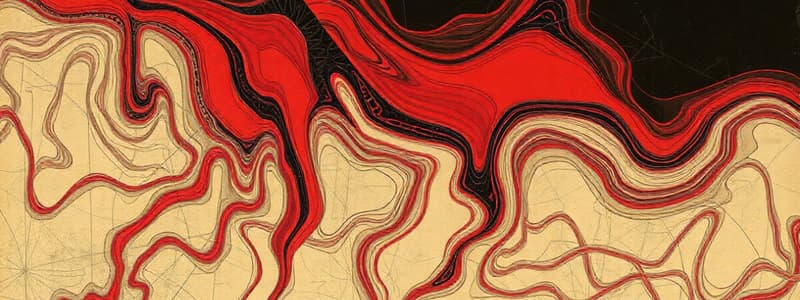Podcast
Questions and Answers
What is the effect of increasing the length of a tube on fluid flow according to Poiseuille's law?
What is the effect of increasing the length of a tube on fluid flow according to Poiseuille's law?
- Increases pressure gradient
- Increases flow rate
- Has no effect on flow rate
- Decreases flow rate (correct)
Which factor does NOT affect the flow rate according to Poiseuille's law?
Which factor does NOT affect the flow rate according to Poiseuille's law?
- Fluid density (correct)
- Pressure gradient
- Tube radius
- Viscosity
What condition indicates that flow is transitioning from laminar to turbulent according to Reynolds number?
What condition indicates that flow is transitioning from laminar to turbulent according to Reynolds number?
- Re between 1000 and 2000
- Re = 2000
- Re < 1000
- Re > 2000 (correct)
What happens to the vascular conductance when flow becomes turbulent?
What happens to the vascular conductance when flow becomes turbulent?
Which of the following best defines laminar flow?
Which of the following best defines laminar flow?
Which statement about blood viscosity is true?
Which statement about blood viscosity is true?
What is the consequence of the Fahraeus-Lindqvist effect?
What is the consequence of the Fahraeus-Lindqvist effect?
How does increasing the number of resistances in parallel affect total resistance in the cardiovascular system?
How does increasing the number of resistances in parallel affect total resistance in the cardiovascular system?
What effect does polycythemia have on blood viscosity according to the relationship outlined in the content?
What effect does polycythemia have on blood viscosity according to the relationship outlined in the content?
Which of the following factors is least likely to affect blood viscosity as described?
Which of the following factors is least likely to affect blood viscosity as described?
In the context of the Fahreaus-Linqvist effect, when does viscosity decrease?
In the context of the Fahreaus-Linqvist effect, when does viscosity decrease?
Which statement best describes the relationship between pressure, flow, and resistance in the cardiovascular system?
Which statement best describes the relationship between pressure, flow, and resistance in the cardiovascular system?
What is the significance of the Reynolds number in blood flow?
What is the significance of the Reynolds number in blood flow?
What is the primary factor that determines blood flow (Q) in the cardiovascular system?
What is the primary factor that determines blood flow (Q) in the cardiovascular system?
According to the law of Laplace, which condition leads to increased wall tension (T) in a blood vessel?
According to the law of Laplace, which condition leads to increased wall tension (T) in a blood vessel?
How is the total intravascular pressure (Ptotal) calculated?
How is the total intravascular pressure (Ptotal) calculated?
Which of these equations correctly represents cardiac output (CO)?
Which of these equations correctly represents cardiac output (CO)?
What is the relationship between resistance (R) and conductance (g) in blood flow?
What is the relationship between resistance (R) and conductance (g) in blood flow?
In which part of the cardiovascular system is the blood volume normally greatest?
In which part of the cardiovascular system is the blood volume normally greatest?
What component of blood pressure is primarily responsible for the movement of blood in the arteries?
What component of blood pressure is primarily responsible for the movement of blood in the arteries?
Using the formula for estimating blood volume, how much blood would a 70 kg person have?
Using the formula for estimating blood volume, how much blood would a 70 kg person have?
What is the primary function of the cardiovascular system?
What is the primary function of the cardiovascular system?
How is blood volume distributed within the cardiovascular system?
How is blood volume distributed within the cardiovascular system?
What factors determine blood flow resistance according to Poiseuille's law?
What factors determine blood flow resistance according to Poiseuille's law?
Which statement about turbulent blood flow is correct?
Which statement about turbulent blood flow is correct?
What is the normal hemoglobin concentration associated with the standard oxygen content in blood?
What is the normal hemoglobin concentration associated with the standard oxygen content in blood?
How does the Farhrus-Lindqvist effect influence blood viscosity?
How does the Farhrus-Lindqvist effect influence blood viscosity?
What is the significance of the law of Laplace in relation to the cardiovascular system?
What is the significance of the law of Laplace in relation to the cardiovascular system?
What is the approximate normal oxygen content in blood based on the standard hemoglobin level?
What is the approximate normal oxygen content in blood based on the standard hemoglobin level?
Flashcards are hidden until you start studying
Study Notes
Velocity, Flow, and Area
- Flow (Q) is the product of velocity (v) and cross-sectional area (A): Q = v × A.
- Velocity can be calculated from flow and area: v = Q/A.
Poiseuille’s Law and Resistance
- Poiseuille’s experiments demonstrated that blood flow is affected by pressure gradient (ΔP), length of the vessel (L), radius of the vessel (r), and fluid viscosity (η).
- Blood flow (Q) is proportional to the pressure gradient (ΔP) and the fourth power of radius (r^4), and inversely proportional to vessel length (L) and viscosity (η).
- Poiseuille’s Law is mathematically expressed as: Q = (ΔPr^4π) / (ηL8).
Total Resistance in the Cardiovascular System
- Total resistance is the cumulative effect of resistances in series and parallel configurations.
- Increasing the number of vessels in parallel decreases total resistance.
Laminar and Turbulent Flow
- Laminar flow occurs in layers, with the fastest flow in the center of the vessel; velocity profile resembles a parabolic shape.
- Turbulent flow occurs when lamina breakdown, resulting in decreased vascular conductance and increased resistance to flow.
- Reynold's Number (Re) indicates flow type: Re < 2000 suggests laminar flow, while Re > 2000 indicates turbulence.
- Turbulence may arise at vessel bends, branch points, or stenotic valves.
Blood Viscosity
- Blood is classified as a non-Newtonian fluid, exhibiting variable viscosity under different flow conditions.
- The Fahraeus-Lindqvist effect describes reduced apparent viscosity when vessel diameter is less than 0.2 mm due to axial accumulation of red blood cells (RBCs).
Learning Objectives
- Understand the differences in O2 content and saturation between arterial and venous blood, along with normal heart chamber pressures.
- Familiarize with normal hematocrit, hemoglobin levels, and plasma electrolyte values (K+, Na+, Ca²+).
- Recognize blood volume distribution in the cardiovascular system and estimate total blood volume based on body weight.
- Analyze the relationship between pressure, flow, and resistance and its implications on wall tension (law of Laplace).
- Distinguish between laminar and turbulent flow and factors influencing each type.
- Identify factors affecting blood viscosity and the implications of the Fahraeus-Lindqvist effect.
Cardiovascular System Overview
- The heart beats approximately 115,000 times daily, pumping about 7,230 liters of blood at rest.
- Blood pressure peaks at about one-sixth of an atmosphere, generating roughly two watts of mechanical power.
- The cardiovascular system functions as a closed-loop network supporting organ blood supply and performing essential roles like oxygen delivery, metabolic waste removal, hormone transport, immune response, temperature regulation, and fluid volume balance.
Key Hemodynamic Features
- Blood volume constitutes 7-8% of body weight; estimate it using: blood volume (L) = body weight (kg) × 0.08.
- Blood velocity decreases in capillaries where the cross-sectional area is maximized.
Relationships in Hemodynamics
- Pressure in the system correlates with flow and resistance: P = Q × R.
- Total intravascular pressure consists of static and dynamic components: P_total = P_static + P_dynamic.
Law of Laplace
- Transmural pressure (ΔP) represents the difference between internal and external pressures across a vessel wall.
- Wall tension (T) relates to radius and wall thickness, following the law of Laplace: T = ΔPr/h (for cylinders) and T = ΔPr/2h (for spheres).
Important Fluid Dynamics Concepts
- Increased vessel radius elevates tension on vessel walls, even if pressure remains constant.
- The presence of a cell-free layer at blood vessel walls enhances flow dynamics according to the Fahraeus-Lindqvist effect.
- Blood viscosity, affected by hematocrit levels, influences resistance; high hematocrit (polycythemia) raises viscosity and resistance, while low hematocrit (anemia) decreases both.
Studying That Suits You
Use AI to generate personalized quizzes and flashcards to suit your learning preferences.




